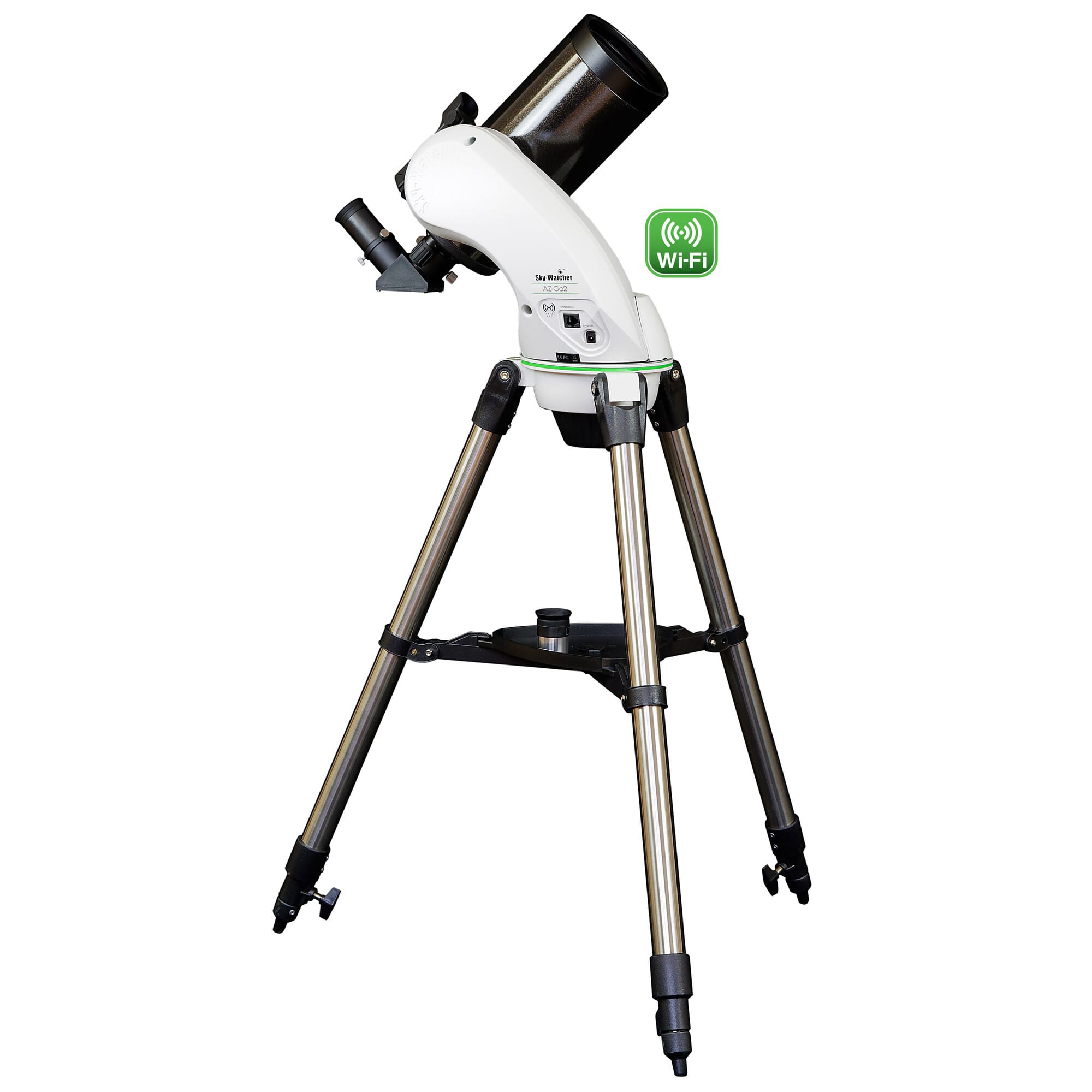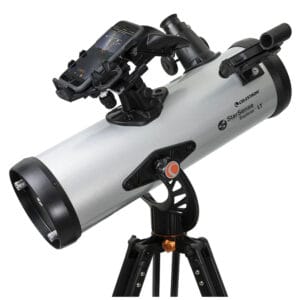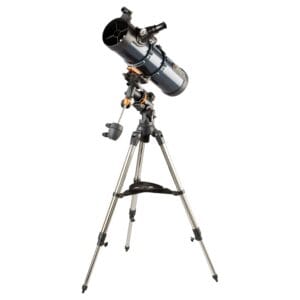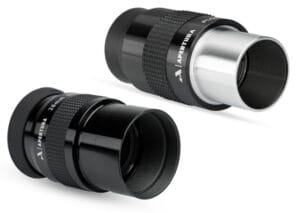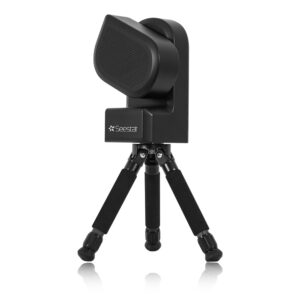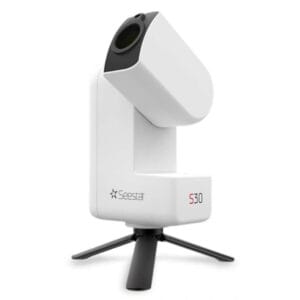What is a reflector telescope? It’s a question many beginning stargazers ask. A reflector telescope is a type of telescope that uses mirrors to collect light and show a magnified image of celestial bodies. Unlike a lens telescope (refractor), with a reflector you observe the universe through a clever system of mirrors.
In this blog, we’ll explain step by step what a reflector telescope is, how it works, what you can see with it, and why many stargazers choose this type. Whether you’re looking for your first telescope or want to understand the difference between models, this article is your clear starting point.
How Does a Reflector Telescope Work?
A reflector telescope (also called a Newtonian telescope) consists of three main components:
- Primary mirror – this large, curved mirror is located at the back of the tube and captures light from space.
- Secondary mirror – a smaller flat mirror directs the reflected light from the primary mirror to the side of the tube.
- Eyepiece – this is what you look through. The eyepiece magnifies the image so you can actually see it.
Instead of refracting light through a lens, as with a refractor, here it is reflected, hence the name “reflector”.
What Can You See with a Reflector Telescope?
Thanks to their large mirrors, reflectors capture a lot of light. This makes them particularly suitable for:
✓ Faint deep-sky objects like nebulae, star clusters, and galaxies
✓ Planets like Jupiter, Saturn, and Mars
✓ The Moon in striking detail
✓ Double stars and open clusters
You see more than just points of light: you can recognize structures in the Orion Nebula, see Saturn’s rings, or track Jupiter’s moons over several evenings.
What are the Advantages of a Reflector Telescope?
A reflector offers great value for money, making it popular with both beginners and advanced users. The main advantages:
✓ More aperture for less money – you get a large mirror with high light gathering power relatively cheaply
✓ Perfect for deep-sky – the larger the mirror, the more light you collect, which is crucial for observing faint objects
✓ No chromatic aberration – lenses can distort colors (like blue or purple edges around bright objects); mirrors don’t have this problem
✓ Compact design with long focal length – an f/5 or f/6 reflector, meaning the focal length is 5 to 6 times the mirror’s diameter, has a relatively short tube. The lower this f-number, the wider the field of view and the more compact the telescope. This makes it ideal for viewing large objects like nebulae, and comfortable to use.
For those who want to “look beyond the moon”, a reflector is often the best choice.
What are the Disadvantages of a Reflector Telescope?
No system is perfect. Reflectors also have disadvantages:
✗ Collimation required – mirrors need occasional alignment. This can be done easily with a simple collimator
✗ Open tube construction – more sensitive to dust and dew, especially with Dobsonians without tube protection. Fortunately, you can purchase dew shields from us to protect your telescope
✗ Image is inverted or mirrored – not an issue for astronomical use, but inconvenient for terrestrial observation
✗ Slightly less contrast for planets – lenses sometimes have an advantage here due to sharper images of smaller objects
But for the price/quality ratio, this type is excellent, especially if you’re willing to learn a bit.
What Types of Reflector Telescopes are there?
The most common variant is the Newtonian reflector, named after Isaac Newton, who invented this design. He combined simplicity, optical power, and low cost in one system.
Additionally, there are more advanced systems such as:
- Dobsonians – Newtonian telescopes on a simple rotating wooden base. They’re popular due to their low price, large mirror diameter, and ease of use.
- Ritchey-Chrétien – mainly for astrophotography. More expensive, complex, but very sharp image.
- Cassegrain variants – compact telescopes with a longer focal length. More for advanced users or planet enthusiasts.
For beginners, Dobsonians (like the Heritage 130/650 or Sky-Watcher 150/750) are by far the most recommended. You get a large aperture, minimal fuss, and you can start observing right away.
How Do You Choose the Right Reflector Telescope?
Consider these factors:
- Mirror diameter (aperture): The larger the mirror, the more light. 130mm is a good starting point; 150-200mm really opens up the deep-sky world.
- Focal length (f-number): f/5 is wide-field (for nebulae), f/8 is more zoomed in (for planets).
- Mount – A Dobsonian is ideal for visual use. For photography, you need an equatorial mount.
- Collimation ease: Preferably choose a tube with thumbscrews or buy a simple laser collimator.
Check the telescope selection guide at Telescoop.nl to quickly find which models suit your needs.
How Do You Maintain a Reflector Telescope?
- Collimation: check every few weeks (or after transport) with a collimation tool
- Keep dust-free: use a dust cap and store the telescope indoors or in a padded bag
- Prevent condensation: let the telescope acclimatize for outdoor use and don’t store it away wet
- Cleaning: only clean the mirrors when absolutely necessary, and always with care (or have it done professionally)
Regular maintenance extends the lifespan and ensures a sharp image.
How much Does a Good Reflector Telescope Cost?
Reflectors are budget-friendly. For €150-€300 you can already get a solid 130mm Newton. If you want more light and better details, you’re looking at around €400-€600. And if you want to do serious deep-sky viewing with 200mm or more, expect to pay €600 to €900 – still cheaper than a refractor with equivalent performance.
An example model is the Sky-Watcher Heritage 130P Dobson – compact, powerful, and easy to use.
Why Do so many Beginners Choose a Reflector Telescope?
- ✓ Largest aperture for the least money
- ✓ Immediately suitable for deep-sky and planets
- ✓ Wide range of accessories, filters, and eyepieces available
- ✓ Easy to set up and learn
- ✓ Lots of online tutorials and community support
For many people, a reflector is the ideal first step into astronomy. It’s no coincidence that models like the Heritage 130 or Sky-Watcher 150/750 have been bestsellers among beginners and experienced amateurs for years.
Conclusion: is a Reflector Telescope Right for You?
A reflector telescope is the perfect combination of simplicity, power, and affordability. You literally look deeper into the universe, and learn how it works along the way. Interested in nebulae, galaxies, and planets? Then this type is an excellent start.
✔ For beginners: get a 130 or 150mm Dobsonian
✔ For those with some experience: consider 200mm or more
✔ For the curious: discover the beauty of the universe without technical barriers
→ Want to know more? Check out the current selection of reflector telescopes at Telescoop.nl or read our guide for beginning stargazers.

